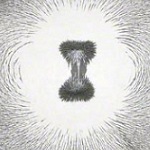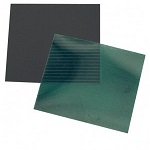The Earth behaves like one large magnet; we know this for certain because of the visible effects on a magnetic compass by the Earth’s magnetic field. In 1600 William Gilbert was the first physician to publish his findings on the Earth’s magnetic field and a hypothesis for its origin in his book titled de Magnete.
Why does the Earth have a magnetic field?
21st century scientists believe the magnetic field is generated from the Earth’s iron core which is approximately two thirds the size of the moon and as hot as the surface of the sun, around 5,700oC to be exact. Theoretically, this should cause the solid iron inner core to melt, however, the extreme pressure of gravity on the core prevents it melting. Closer to the Earth’s surface, surrounding the inner core is a 12,000 mile thick layer of molten material primarily consisting of iron and nickel.
Subsequent differences between this outer and inner core such as temperature and pressure cause convection currents in the molten layer. A convection current occurs when hot liquid rises into a cooler area and cooler, more dense material sinks. The spin of the Earth on its axis also causes swirling currents and as the liquid iron flows, it generates electrical currents, and, where there is an electrical current there is always a magnetic field. For the Earth’s magnetic field to last over billions of years it relies on these convection currents to continually generate. This self-sustaining cycle is known as the geodynamo.
About the Earth’s magnetic field
It is a common misconception that a magnetic compass points towards the Earth’s geographic north pole; instead a compass points towards the Earth’s magnetic poles. The second misconception is that the magnetic pole in the region of the geographic North Pole is the magnetic north pole, when actually it is the magnetic south pole. When you consider that opposite magnetic poles attract it is apparent that this should be the case as the north end of a compass is attracted to the magnetic south pole, and therefore a compass points in the direction of the magnetic south pole, and by default the geographic North Pole.
The geographic poles are the points where the Earth’s axis penetrates the surface whereas the magnetic poles are the points where the magnetic field lines of the Earth start and finish, that’s why the geographic poles and magnetic poles don’t exactly align. The magnetic poles are also continually moving, even from year to year. Over the last 100 or so years, the north magnetic pole has been traveling north-west. In reality, the magnetic poles move in rotations, for example the magnetic north pole moves in rotations of approximately 50 miles per day. The average position of these rotations is also migrating, in fact, the magnetic north pole has moved over 500 miles in the last 150 years. The changes we see on the surface are a result of the inner core spinning more quickly than the planet itself, combined with the chaotic, turbulent ocean of convection currents in the outer core.
Detecting the Earth’s magnetic field
The simplest way to detect the Earth’s magnetic field is with a compass, you can even make your own as a great way to teach youngsters about magnetism. A compass will only tell you the direction of the Earth’s magnetic poles and most new smartphones come with a handy digital compass built in. A smartphone also uses inbuilt accelerometers and magnetometers to determine direction and speed, very useful for GPS based apps like sat-navs! There are also several great apps available that let you detect the Earth’s three-dimensional magnetic field. Search the relevant app store to experiment with these for yourself.
The Earth’s magnetic field in action

The Earth’s magnetic field plays a really important role in protecting everyone from the Sun’s solar winds, which consist of streams of charged particles that emit radiation. The Earth’s magnetic field, high above the planet’s surface in an area known as the magnetosphere deflects these dangerous rays keeping us safe from harm.
A beautiful and stunning result of these charged particles emitted by the Sun colliding with the magnetosphere is the Aurora Borealis or northern lights. The auroras are created by the electrically charged particles from the sun colliding with gaseous atoms in the magnetosphere causing them to give off light.
Detecting a magnet’s magnetic field
So, in summary, the Earth behaves in many ways like a large permanent magnet and while this is super-interesting, the chances are you are more likely to need to identify the poles of a permanent magnet you wish to use, rather than the direction of the Earth’s magnetic poles. Obviously magnetic fields are invisible so here we take a look at how you can identify them.
If you sprinkle iron filings on to a sheet of A4 paper and position a magnet underneath the filings align in the formation of the magnet’s magnetic field. A great experiment for kids.
Magnetic field paper is a micro-encapsulated film which changes colour when placed in an external magnetic field, displaying the positions of a magnet’s poles and the pitching lines between them.
Analogue and digital pole testers are readily available and are the quickest way to identify the poles of a magnet.
Of course, no one carries a pole tester around with them all the time, but the majority of us do have our smart phones. You can download the first4magents Virtual Pole Tester app to turn your smartphone into a digital pole tester!
[subscribe2]






